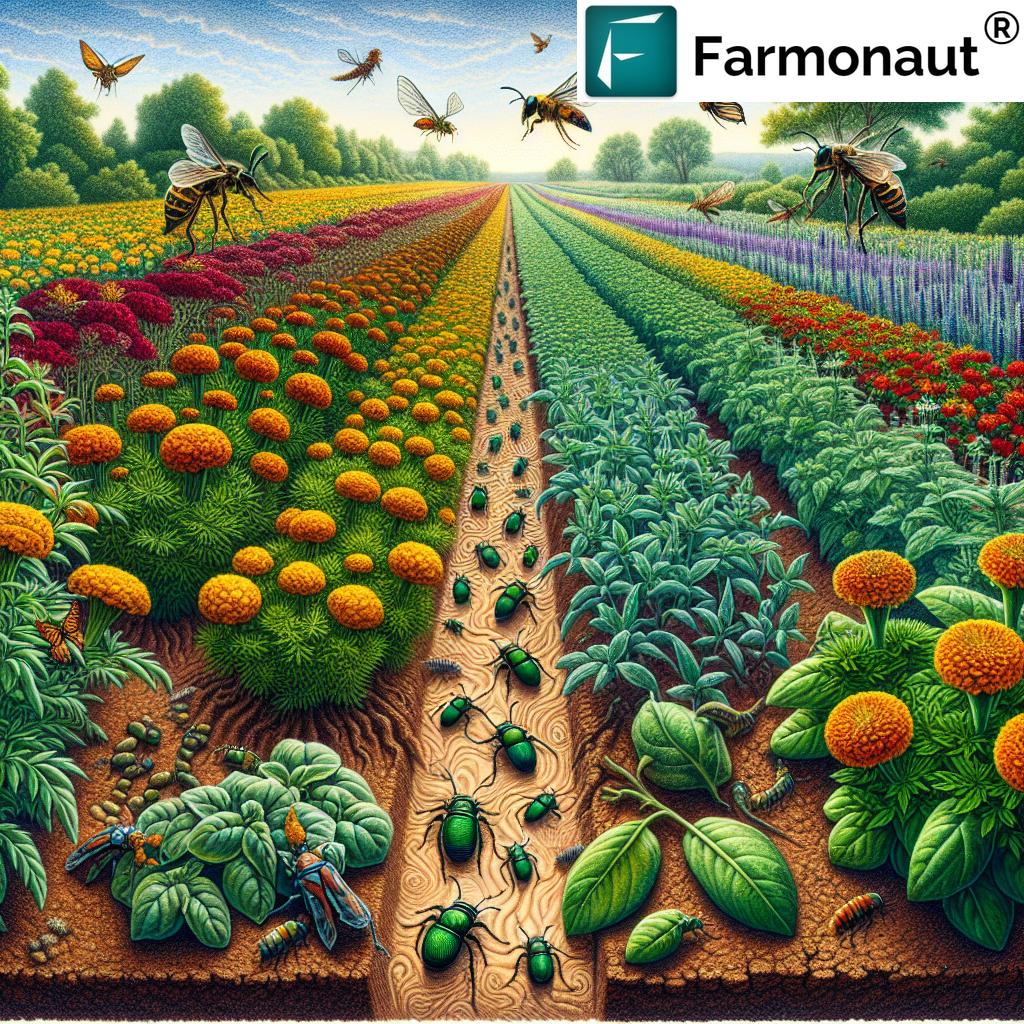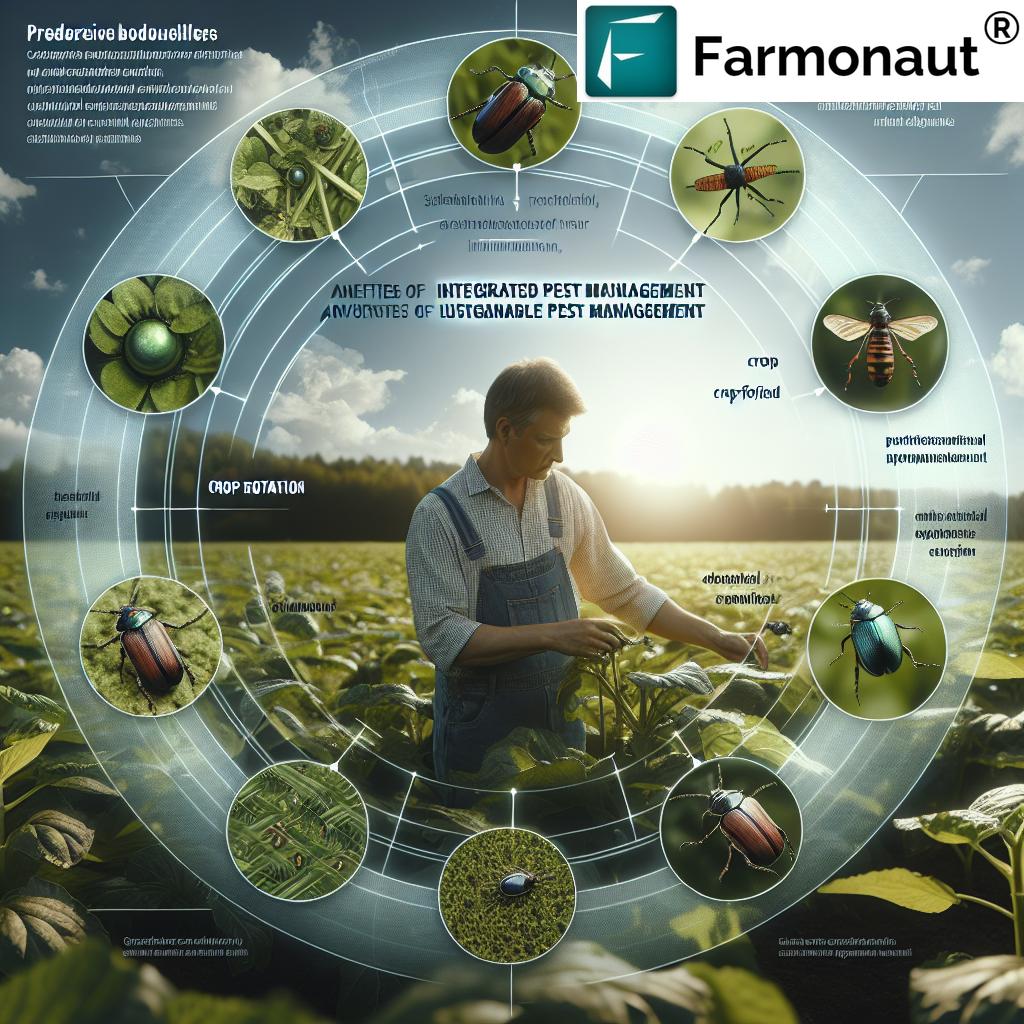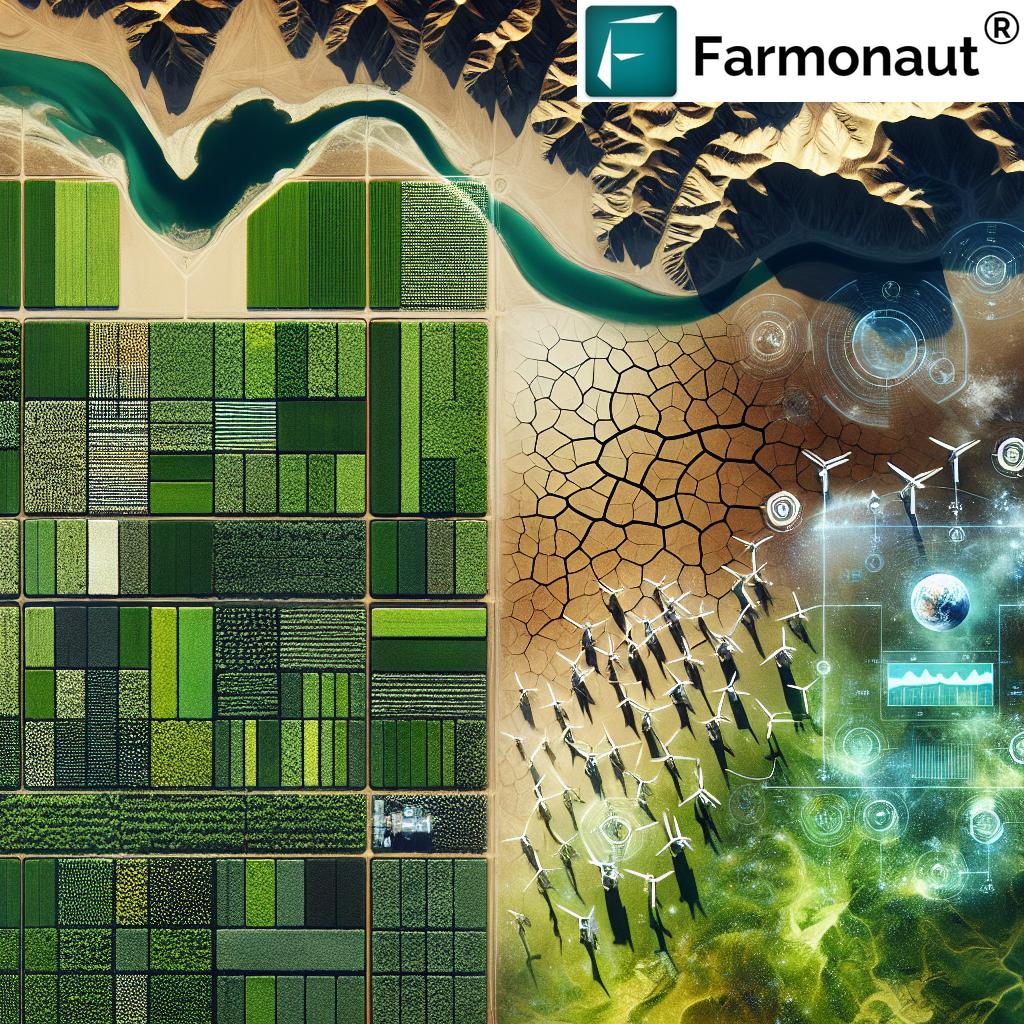Natural Pest Control: 7 Shocking Eco Hacks for Crops
“Natural pest control can reduce pesticide use by up to 70% in sustainable farming systems.”
Summary: Why Natural Pest Control Matters
Natural pest control methods encompass a diverse range of eco-friendly pest management strategies that harness nature’s own ecological principles. By utilizing natural predators, companion planting, crop rotation, and biological control agents, we aim to manage pest populations without relying heavily on chemical pesticides. These natural techniques not only help reduce reliance on chemical pesticides but also safeguard crop health, promote environmental sustainability, and preserve farm biodiversity.
For those of us practicing sustainable agriculture, adopting natural pest control is more than a choice—it’s a necessity for enduring productivity and responsible stewardship of our land.
Natural Pest Control Hacks: An Overview
Let’s dive into the seven most effective natural pest control methods every farmer, gardener, and grower can embrace. Our eco hacks leverage biological pest control, companion planting, push–pull strategies, biosolarization, biofumigation, crop rotation, and mineral-based pesticides. Each method disrupts pest populations in unique ways, and together, these approaches represent a holistic, integrated path toward pest management, soil health improvement, and total farm sustainability.
Our journey through these techniques will empower you to reduce chemical pesticide use, nurture healthy crops, and safeguard our shared future on this planet.
Comparison Table of Natural Pest Control Methods
| Method Name | Description | Estimated Effectiveness (% Pest Reduction) | Environmental Impact | Approximate Cost | Suitable Crops |
|---|---|---|---|---|---|
| Biological Control | Introducing natural enemies (predators, parasitoids) of pests. | 60–80% | Low | Medium | Vegetables, fruits, forestry, field crops |
| Companion Planting | Growing specific plants together to repel/deter pests and attract beneficial insects. | 30–50% | Very Low | Low | Tomatoes, beans, cucurbits, many vegetables |
| Push–Pull Strategy | Uses repellent crops to “push” and trap crops to “pull” pests away. | 50–80% | Low | Low | Maize, sorghum, cereals |
| Biosolarization | Combines organic matter with solar heat under plastic mulch to suppress soil pests. | 50–70% | Low | Medium | Strawberries, tomatoes, lettuce, greens |
| Biofumigation | Incorporates Brassicaceae plants into soil, releasing biofumigants to control pests. | 50–75% | Low | Low | Various vegetables, tubers, field crops |
| Crop Rotation | Regularly alternating crops to break pest and disease cycles and improve soil health. | 40–70% | Very Low | Very Low | All annual crops |
| Mineral-Based Pesticides | Using minerals like sulfur to disrupt pest metabolism and control diseases. | 30–60% | Medium | Low | Fruits, grapes, vegetables |
1. Biological Pest Control: Harnessing Nature’s Predators
Biological pest control is one of the most sustainable agriculture practices we can adopt. This method involves introducing natural enemies—such as predators, parasitoids, or pathogens—into the ecosystem to regulate pest populations. By carefully selecting and releasing species that specifically target harmful pests, we reduce reliance on chemical pesticides and promote biodiversity on our farms.
How Biological Pest Control Works
- Predators: Organisms like lady beetles (Coccinellidae family) and lacewings are natural enemies of aphids, whiteflies, and other soft-bodied pests. Lady beetles, for example, are especially effective in reducing aphid populations—one beetle can eat up to 5,000 aphids in its lifetime!
- Parasitoids: Insects such as certain wasps lay eggs inside pest larvae. The developing parasitoids consume their host from within, providing long-term pest suppression.
- Pathogens: Microorganisms (fungi, bacteria, nematodes) can be applied to target pest species. These pathogens infect and kill pests, disrupting population growth.
Example: The release of the black lady beetle, Sasajiscymnus tsugae, has been highly effective against the hemlock woolly adelgid—a damaging pest threatening hemlock trees in North America. Reports show a significant decrease in adelgid densities just months after these beetles are introduced.
- Benefits:
- Targets only harmful pests, preserving beneficial insects.
- Maintains ecological balance and biodiversity.
- Environmentally sound and long-term solution.
When integrating biological control agents into our fields, it’s crucial to match predators to the correct pest species. This approach forms part of integrated pest management, ensuring pest populations are contained in an eco-friendly manner.
Looking for a large-scale, tech-enabled system to monitor biological pest control effectiveness across plantations or contract farms? Farmonaut’s Agro Admin App provides centralized, satellite-based monitoring and actionable insights for teams, making sustainable pest management easier than ever.
2. Companion Planting for Pest Control: Nature’s Buddy System
Companion planting stands as a time-tested strategy for eco-friendly pest control. By growing specific plants together, we can harness their natural properties to repel or deter pests and attract beneficial insects.
- Repelling Pests: Aromatic plants like marigold are known to repel nematodes and some soil-borne pests. Planting marigolds among vegetable crops (such as tomatoes and beans) provides a natural barrier.
- Interplanting for Benefits: Herbs like basil and dill, when grown near crops, minimize aphid populations by attracting predators (such as lady beetles and predatory wasps) and repelling harmful insects with their scent.
- Attracting Natural Predators: Companion planting can provide nectar and pollen to beneficial insects, sustaining populations of pollinators and pest-eating species.
Companion planting isn’t just about pest control—it’s key to enhancing biodiversity, soil health, and improving crop yields without chemical inputs. This method works best when we consider plant compatibility, pest lifecycles, and local environmental conditions.
[Did You Know?]
“Companion planting has been shown to decrease pest populations by 40% in eco-friendly crop management.”
3. Push–Pull Strategy: Steering Pests the Eco Way
The push–pull strategy is a smart integrated pest management approach that combines repellent and attractive plants to protect our main crops from harmful pests.
- Push: “Push” plants (e.g., desmodium) are interplanted or used as border crops. They emit volatile chemicals that repel pests away from the main crop. For instance, desmodium is highly effective in repelling stem borers from maize.
- Pull: “Pull” plants (e.g., Napier grass) are placed at the field edge. They act as trap crops, attracting pests (like stemborers and striga weeds) away from the main crop, keeping infestations under check.
Developed and popularized in regions like Kenya, this technique is especially effective for maize and sorghum fields, but adaptable to global conditions. It leverages ecological balance and reduces the need for chemical pesticides by diverting pest populations and promoting beneficial insects.
- Benefits:
- Significantly reduces pest infestation without chemicals.
- Enhances biodiversity and soil cover.
- Cost-effective and scalable for diverse farming operations.
Interested in crop advisory and plantation management tools to support complex natural pest control strategies? Visit Farmonaut’s Platform for live monitoring, custom advice, and satellite-driven field insights for organic and conventional farmers.
4. Biosolarization & 5. Biofumigation: Harnessing Heat and Plant Chemistry
Biosolarization: Solar-Powered Soil Pest Management
Biosolarization combines organic amendments (manure, crop residues, compost) with the power of the sun. Here’s what we do:
- Mix organic matter into moist soil.
- Cover the treated area with transparent plastic sheets.
- Solar radiation heats the soil under the plastic, while decomposition of organics produces natural biocides.
This process creates a hostile environment for soil-borne pests—such as nematodes, fungal pathogens, weeds, and insect larvae—by combining solar heat and microbial activity.
Farmers in strawberry production have adopted biosolarization as an effective alternative to chemical soil fumigants.
Biofumigation: Letting Plants Fumigate for Us
The biofumigation method leverages Brassicaceae family plants—mustard, radish, and related species—known for producing natural compounds (isothiocyanates) toxic to many pests and diseases.
- Grow a cover crop of mustard or similar species.
- Chop and incorporate these plants into the soil at flowering stage.
- As the plants decompose, they release biofumigant gases that disrupt pest lifecycles.
Biofumigation is the perfect natural alternative to chemical fumigation: it’s sustainable, enhances soil health, and safely manages soil pathogens and pests.
Did you know? Farmonaut’s Carbon Footprinting module helps you monitor CO₂ savings when you switch to natural pest control methods like biosolarization and biofumigation—empowering farms to meet global climate commitments and regulatory standards.
6. Crop Rotation Benefits: Disrupting Pest Cycles & Revitalizing Soil Health
Crop rotation is the regular practice of planting different crop species in the same field across successive seasons. This sustainable agriculture method:
- Disrupts host-specific pest lifecycles: Pests and pathogens that thrive on one crop are left without a host when we rotate crops, significantly reducing their populations.
- Prevents soil depletion: Different plants utilize and replenish various nutrients, resulting in improved soil fertility.
- Improves overall crop health: Reduces disease build-up and supports soil microbial diversity.
For example, rotating legumes (like beans and peas) with cereals (like maize and wheat) not only diminishes pest pressure but also naturally enriches soil nitrogen.
Crop rotation creates powerful data for sustainability initiatives. With Farmonaut’s Traceability solution, growers and food companies can transparently showcase their eco-friendly crop management—building consumer trust and unlocking new market opportunities.
7. Mineral-Based Pesticides: Old-School, Nature-Powered Protection
Some minerals—like sulfur and kaolin clay—are highly effective at controlling pests and diseases naturally:
- Sulfur:
- Controls fungal diseases (powdery mildew, scab) and pests like spider mites by disrupting their metabolic processes.
- Is often part of organic farming toolkits and works well in combination with other pest management strategies.
- Kaolin Clay & Diatomaceous Earth:
- Applied as a dust or slurry, these minerals create a barrier and physically deter insect pests without toxic chemicals.
- Are safe, affordable, and can be used on fruits, vegetables, and ornamental crops.
While mineral-based products may not have the “firepower” of synthetic pesticides, they are cornerstones of organic pest control—enabling eco-friendly farming and reducing environmental impact.
For growers seeking to verify the reduction of chemicals on their farms and support eco-labeled lending, Farmonaut’s Crop Loan & Insurance platform leverages satellite-based verification, ensuring credibility and transparency in all your sustainable initiatives.
Integrated Pest Management: A Holistic Approach
Integrated Pest Management (IPM) combines the best elements of all natural pest control methods—including those above—with careful monitoring and threshold-based action.
- Monitor: Use tools (such as satellite imagery and on-ground scouting) to detect pest outbreaks early.
- Combination of Strategies: Employ biological controls, companion planting, crop rotation, biosolarization, and occasional mineral-based sprays in a coordinated way.
- Threshold Action: Only intervene (using eco-friendly or targeted measures) when pest populations surpass a tolerated threshold—thus reducing costs and environmental impact.
This approach epitomizes eco-friendly pest control strategies: it’s cost-effective, adaptable, and enhances farm sustainability across agriculture and forestry sectors globally.
Eco-Friendly Pest Monitoring and Decision Support with Farmonaut
We live in an era where technology can amplify every sustainable farming principle. At Farmonaut, we help growers transform natural pest control methods into actionable results. Our integrated, data-driven tools support all stages of eco pest management:
- Satellite-Based Pest and Crop Health Monitoring: Detect pest stress, analyze vegetation (NDVI), and track the impacts of IPM and natural strategies at field and plantation scale.
- Real-Time Insights: Our Jeevn AI Advisory System provides instant, customized advice on crop-specific pest threats, soil health, and best natural management practices, giving farmers the power to decide and act.
- Resource Management: Allocate irrigation, fertilizer, and biological agents precisely—minimizing waste and maximizing yields.
- Blockchain-Based Traceability: Showcase your journey towards an eco-friendly, chemical-free operation with verifiable product traceability at every step—stand out in modern, sustainability-driven markets.
- API Access for Innovators: Seamlessly integrate remote sensing and pest analytics into custom platforms and apps with the Farmonaut API. Full developer resources are available in our API Developer Docs – ideal for agritech startups, precision farming projects, and research.
- Fleet Management: Efficiently manage agricultural machinery, vehicles, and operations with Fleet Management tools, reducing costs and improving logistics. Particularly useful for large-scale, multi-location farms and contract farming operations.
Challenges and Considerations for Natural Pest Control
Despite all the benefits of natural pest control methods, there are practical factors every farm operator must consider:
- Specialized Knowledge: Successful implementation requires understanding pest lifecycles, local ecological dynamics, and timing. Training and continuous learning are essential.
- Initial Investment: Some methods (e.g., biological agents, solarization) may involve upfront costs for new materials or technologies, though they typically reduce costs over time.
- Results May Be Gradual: Natural solutions don’t always deliver “instant” suppression like chemicals. They are most effective as part of a coordinated, season-long integrated strategy.
- Monitoring: Ongoing monitoring of pest populations is needed to adapt strategies and maintain results. Farmonaut’s technology delivers simple, affordable satellite and AI-based monitoring for every scale of operation.
Frequently Asked Questions: Natural Pest Control for Crops
What are natural pest control methods?
Natural pest control methods utilize ecological principles—such as using natural predators, plant properties, companion crops, and rotation—to manage pest populations without chemicals, promoting environmental sustainability.
How effective is biological pest control?
Biological pest control can reduce pest levels by 60–80%, especially when predators and parasitoids are matched to specific pests and integrated within a holistic management plan.
Can companion planting really reduce the need for pesticides?
Yes! Companion planting disrupts pest populations, attracts beneficial insects, and promotes a healthy cropping environment—often reducing chemical needs and improving yields.
What is biosolarization and when should we use it?
Biosolarization combines organic amendments and plastic mulch to use solar heat to control soil-borne pests. It is especially useful in regions with intense sunlight and for crops susceptible to soil-borne diseases, like strawberries or leafy greens.
Do mineral-based pesticides harm beneficial insects?
While sulfur and mineral dusts can deter pests, they are generally less harmful to beneficial insects than broad-spectrum synthetic chemicals—if used as directed and integrated with biological methods.
How can Farmonaut help with natural pest control?
Farmonaut provides affordable satellite-based tools for real-time crop and pest monitoring, soil health analysis, and AI-based advisory—empowering every farm to embrace sustainable, eco-friendly pest management strategies with ease.
Where can I access the Farmonaut platform and mobile apps?
You can access the Farmonaut platform via web app, Android, or iOS app.
Conclusion: Sustainable Agriculture Practices for the Future
Adopting natural pest control methods in our agricultural systems is no longer just a trend but a fundamental shift toward sustainability. By weaving together biological pest control, companion planting for pest control, push-pull strategies, biosolarization, biofumigation, crop rotation, and even mineral-based pesticides, we achieve healthy crops, fertile soil, and thriving farm ecosystems.
These strategies reduce reliance on chemical pesticides, lower production costs, enhance environmental and human health, and create pathways to new markets and certified sustainable products.
At Farmonaut, our mission is to equip every grower—whether in North America, Kenya, or beyond—with affordable satellite, AI, blockchain, and advisory solutions that maximize both the effectiveness and sustainability of pest management.
Let us harness the wisdom of nature, supported by cutting-edge technology, for the most profitable, resilient, and sustainable farms of tomorrow.
Ready to optimize your farm’s sustainability, productivity, and pest management? Start with Farmonaut today—embrace the next generation of eco-friendly agriculture.












